The 3D-Printed Personalized Masks Market is expected to record a valuation of USD 1,050.3 million in 2025 and USD 4,200.5 million in 2035, with an increase of USD 3,150.2 million, which equals a growth of 193% over the decade. The overall expansion represents a CAGR of 14.9% and a 2X increase in market size.
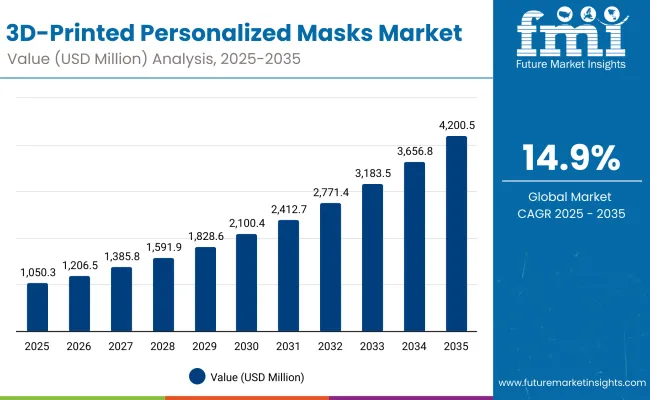
3D-Printed Personalized Masks Market Key Takeaways
| Metric | Value |
|---|---|
| 3D-Printed Personalized Masks Market Estimated Value in (2025E) | USD 1,050.3 million |
| 3D-Printed Personalized Masks Market Forecast Value in (2035F) | USD 4,200.5 million |
| Forecast CAGR (2025 to 2035) | 14.9% |
During the first five-year period from 2025 to 2030, the market increases from USD 1,050.3 million to USD 2,100.4 million, adding USD 1,050.1 million, which accounts for 33.3% of the total decade growth. This phase records steady adoption in at-home personalized skincare kits and sheet mask customization, driven by the need for hydration and anti-aging solutions. At-home kits dominate this period as they cater to over 52.5% of consumer demand, while hydration-based functions account for 46.6% of total usage.
The second half from 2030 to 2035 contributes USD 2,100.1 million, equal to 66.7% of total growth, as the market jumps from USD 2,100.4 million to USD 4,200.5 million. This acceleration is powered by widespread deployment of AI-driven personalization engines, dermatology clinic integration, and 3D bioprinting advancements. Custom-fit gels, patches, and capsules expand their share, while sheet masks maintain a near-equal balance of 49.9% in 2025 and 51.2% in China alone. Clinic-based adoption and in-store kiosks are expected to strengthen in this phase, complementing the at-home kit segment and diversifying revenue streams.
From 2020 to 2024, the 3D-Printed Personalized Masks Market grew from a nascent niche to a structured ecosystem valued in the hundreds of millions of USD, driven largely by hardware-centric adoption of 3D printing technologies. During this early period, the competitive landscape was dominated by equipment manufacturers and material suppliers, who controlled nearly 70-75% of revenue.
Leaders such as Stratasys, CELLINK, and Raphas focused on precision printing hardware and bio-material formulations for healthcare and cosmetics applications. Competitive differentiation relied on printing accuracy, speed, and material safety, while software remained bundled as an auxiliary offering rather than a primary revenue stream. Service-based personalization models had minimal traction, contributing less than 10% of the total market value.
Demand for 3D-Printed Personalized Masks will expand to USD 1,050.3 million in 2025, and the revenue mix will start to shift as consumer-facing solutions and software-enabled services grow toward 30-35% share. Traditional hardware leaders face rising competition from digital-first beauty and healthcare players offering AI-driven personalization, skin-data visualization, and subscription-based mask replenishment services.
Major printing vendors are pivoting to hybrid models, integrating analytics, dermatology partnerships, and remote workflow capabilities to retain relevance. Emerging entrants specializing in cloud interoperability, AR/VR-driven consumer trials, and biotech-enabled mask formulations are gaining share. The competitive advantage is moving away from hardware innovation alone to ecosystem strength, recurring revenue, and consumer loyalty platforms.
Growth is fueled by the convergence of dermatological diagnostics with 3D mask production. Skin-analysis devices and smartphone-linked apps now map hydration levels, pore size, and pigmentation, enabling highly customized formulations. This diagnostic-driven approach transforms masks from generic skincare into precision treatments, making personalization the central value proposition and driving higher adoption across both at-home and clinical environments.
The incorporation of bio-inks and skin-compatible polymers into 3D printing has enabled masks that adapt to facial contours while carrying active ingredients more effectively. These materials allow longer wear times, better absorption, and even controlled release of actives like peptides or ceramides. As bioprinting technology matures, cosmetic brands are leveraging these innovations to differentiate premium offerings, pushing consumer demand for advanced personalized mask solutions.
The 3D-Printed Personalized Masks Market is segmented by component, print technology, product type, function, consumer offering, end-use industry, and region. Components include hardware such as 3D printers, accessories, and software platforms that enable mask customization. Print technologies cover extrusion-based, inkjet bioprinting, and laser-assisted methods, each supporting different levels of precision and material compatibility.
Product types span sheet masks, patches, custom-fit gels, and capsules, while functions include hydration, anti-aging, brightening, and spot treatment. Consumer offerings extend across at-home kits, in-store kiosks, and dermatology clinics, reflecting diverse access points for personalization.
End-use industries include healthcare, consumer goods, sports and fitness, entertainment, and fashion. Regionally, the market scope spans North America, Latin America, Europe, Asia-Pacific, and the Middle East & Africa, with key countries such as the USA, China, Japan, India, Germany, France, and the UK shaping adoption trends.
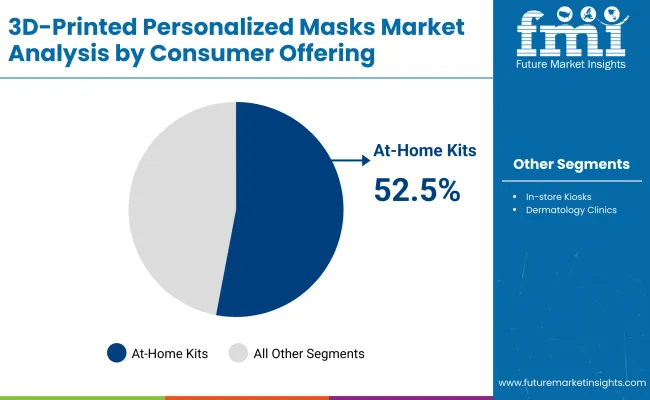
| Consumer Offering | Value Share % 2025 |
|---|---|
| At-home kits | 52.5% |
| Others | 47.5% |
The at-home kits segment is projected to contribute the largest share of the 3D-Printed Personalized Masks Market revenue in 2025, maintaining its lead as the dominant consumer offering category. This is driven by strong consumer demand for convenience, personalization, and immediate accessibility in skincare routines. At-home kits allow users to design and print masks tailored to their skin needs using portable devices or app-driven platforms, reducing reliance on clinics or retail kiosks.
The segment’s growth is further supported by cosmetic brands integrating AI-powered skin diagnostics into home-use devices, enabling data-driven customization. As material science and 3D bioprinting advance, at-home kits are expected to remain the backbone of the market, with wider adoption in premium skincare and wellness routines.
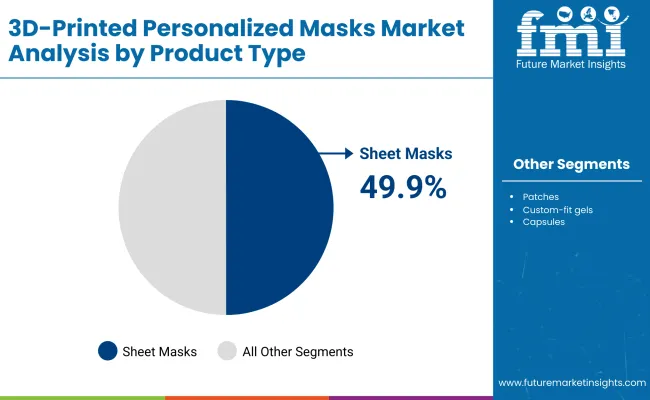
| Product Type | Value Share % 2025 |
|---|---|
| Sheet masks | 49.9% |
| Others | 50.1% |
The sheet masks segment is forecasted to hold the leading share of the 3D-Printed Personalized Masks Market in 2025, driven by its familiarity and ease of consumer adoption. Personalized sheet masks align with existing skincare routines while offering a higher level of customization through 3D-printing technology, making them a preferred option among first-time users. Their lightweight, adaptable format allows precise layering of active ingredients, improving efficacy compared to traditional sheet masks. The segment’s growth is further supported by integration into both at-home kits and clinical offerings, where personalized designs enhance treatment outcomes. As consumer demand for convenient, customizable, and functional skincare grows, sheet masks are expected to retain their position as the most popular product type in the market.
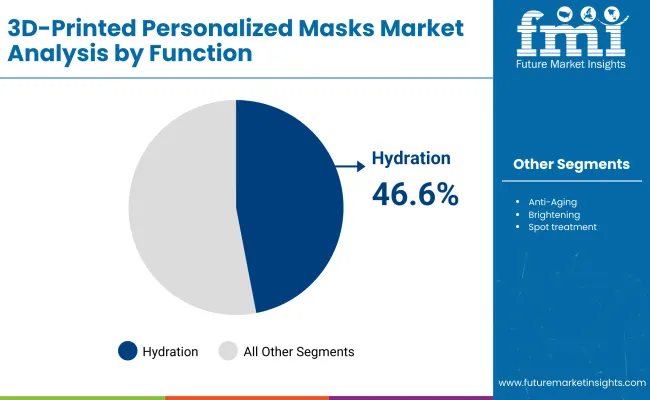
| Function | Value Share % 2025 |
|---|---|
| Hydration | 46.6% |
| Others | 53.4% |
The hydration segment is projected to account for the largest share of the 3D-Printed Personalized Masks Market revenue in 2025, establishing it as the leading function type. This segment benefits from widespread consumer demand for moisture-replenishing skincare, as hydration is considered the foundation of healthy skin across all demographics. Personalized hydration masks created through 3D printing allow precise placement of active ingredients, ensuring targeted delivery where skin needs it most.
The ease of adoption and universal relevance of hydration-focused products have made it a dominant driver of at-home kits and clinical solutions. As innovations in bio-inks and absorbent materials continue to enhance effectiveness, hydration is expected to maintain its leadership position in the market.
AI-Powered Skin Diagnostics
The market is gaining momentum through the integration of AI-driven skin diagnostic tools that analyze hydration levels, pore structure, and pigmentation before generating mask blueprints. This synergy between data analytics and 3D printing enables ultra-personalized skincare solutions, improving both consumer satisfaction and treatment outcomes. The ability to link smartphone apps with home printers and kiosks ensures accessibility across segments, positioning AI diagnostics as a transformative driver of adoption in the personalized mask space.
Biocompatible Materials and Bio-Inks
Innovations in bio-inks and skin-safe polymers are accelerating demand for 3D-printed masks, as these materials allow controlled release of actives and superior adherence to facial contours. Biocompatibility not only ensures safety but also enables enhanced ingredient delivery, reducing wastage and maximizing efficiency.
This breakthrough addresses consumer concerns around sensitivity and irritation, while opening opportunities for premium and functional skincare. The ability to combine advanced ingredients with adaptive material properties is a key factor pushing adoption across both at-home and clinical environments.
High Initial Cost of Devices and Customization
A major barrier to widespread adoption remains the high upfront cost of 3D printers and associated mask customization devices. While cosmetic brands are experimenting with kiosks and clinics, consumer penetration is still limited by price sensitivity in many regions. The investment in hardware, coupled with recurring costs for consumables and cartridges, restricts adoption to premium consumers and urban markets. Unless brands develop affordable models or subscription-based solutions, cost will continue to be a restraint on market expansion.
Dermatology-Clinic Integration with Personalized Treatments
A key trend shaping the market is the growing role of dermatology clinics integrating 3D-printed masks into advanced treatment plans. Clinics are using bioprinting technologies to create post-procedure recovery masks and active ingredient-loaded gels tailored to patient needs.
This enhances the professional skincare experience and positions 3D-printed masks as both therapeutic and cosmetic tools. As partnerships between cosmetic brands and dermatologists expand, the clinic segment is expected to become a critical growth driver, setting the stage for mainstream adoption of 3D personalization.
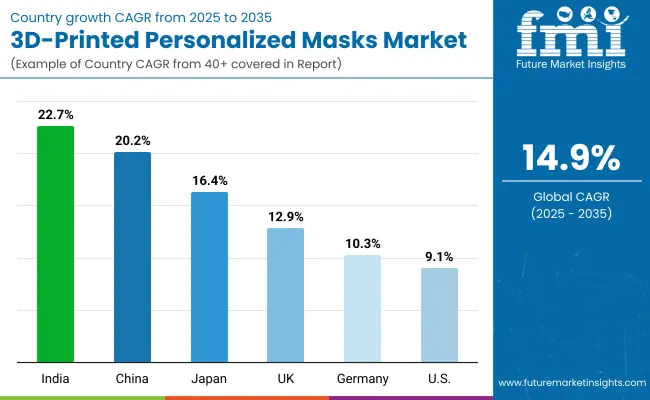
| Country | Estimated CAGR (2025 to 2035) |
|---|---|
| China | 20.2% |
| USA | 9.1% |
| India | 22.7% |
| UK | 12.9% |
| Germany | 10.3% |
| Japan | 16.4% |
The global 3D-Printed Personalized Masks Market shows clear regional differences in adoption, shaped by consumer digital readiness, innovation ecosystems, and beauty-tech investments. Asia-Pacific emerges as the fastest-growing region, anchored by India at 22.7% CAGR and China at 20.2% CAGR. India’s rise is driven by rapid adoption of personalized skincare solutions among urban millennials and expanding availability of low-cost 3D-printed mask kits.
China leads with strong government support for biotech-enabled consumer goods, fueling investment in personalized beauty platforms. Japan (16.4% CAGR) also accelerates, with major cosmetic brands integrating 3D-printed masks into holistic wellness offerings. Europe maintains a steady growth profile, led by the UK (12.9%) and Germany (10.3%), where high consumer acceptance of premium skincare and innovation-driven beauty markets sustains demand.
North America shows more measured expansion, with the USA at 9.1% CAGR, reflecting a mature consumer base that emphasizes clinical-grade personalization and subscription models rather than purely hardware-based solutions.
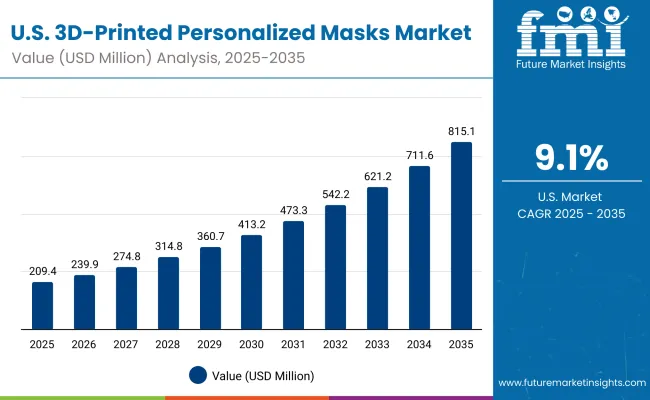
| Year | USA 3D-Printed Personalized Masks Market (USD Million) |
|---|---|
| 2025 | 209.47 |
| 2026 | 239.96 |
| 2027 | 274.88 |
| 2028 | 314.89 |
| 2029 | 360.72 |
| 2030 | 413.23 |
| 2031 | 473.37 |
| 2032 | 542.27 |
| 2033 | 621.20 |
| 2034 | 711.61 |
| 2035 | 815.19 |
The 3D-Printed Personalized Masks Market in the United States is projected to grow from USD 209.47 million in 2025 to USD 815.19 million by 2035, adding over USD 605 million in value during the decade. This expansion reflects a steady year-on-year rise, with the market surpassing USD 360 million by 2029 and crossing the USD 700 million mark by 2034.
Growth is led by the widespread adoption of at-home kits, which accounted for 54.1% of the USA market in 2025 (USD 113.3 million), demonstrating strong consumer demand for convenience and digital personalization. The “others” category, which includes dermatology clinics and in-store kiosks, contributed USD 96.1 million in the same year, highlighting the role of professional channels in supporting credibility and higher-margin services.
The 3D-Printed Personalized Masks Market in the United Kingdom is projected to expand at a steady pace, with an estimated CAGR of 12.9% between 2025 and 2035. Growth is supported by rising consumer awareness of personalized beauty, coupled with the country’s early adoption of premium skincare technologies. At-home kits are expected to dominate, reflecting the preference for AI-driven diagnostics and app-integrated mask printers among digitally savvy consumers.
Retailers in London, Manchester, and Birmingham are piloting in-store kiosks, while dermatology clinics are incorporating personalized hydration and anti-aging treatments into premium service lines. A strong collaboration ecosystem involving cosmetic giants, biotech startups, and academic labs is accelerating material innovation, particularly in bio-inks and sustainable substrates, aligning with the UK’s broader sustainability agenda. This blend of consumer pull, retail innovation, and institutional R&D is positioning the UK as a leader in Europe’s personalized skincare transformation.
India is set to witness one of the fastest expansions in the 3D-Printed Personalized Masks Market, with a projected CAGR of 22.7% between 2025 and 2035. Growth is being driven by a young consumer base, particularly urban millennials and Gen Z, who are highly receptive to affordable personalization in skincare. Falling costs of desktop 3D printers and the rise of localized cartridge production have enabled adoption to spread beyond metros into tier-2 and tier-3 cities.
Domestic cosmetic brands are actively introducing subscription-based models for hydration and brightening masks, ensuring recurring consumer engagement. In parallel, dermatology clinics in major urban hubs are testing 3D-printed post-treatment recovery masks, enhancing the appeal of precision-driven skincare. Additionally, the education sector is creating long-term momentum, with beauty and cosmetology institutes integrating training on mask-printing systems into curricula, preparing professionals for the country’s personalization wave.
The 3D-Printed Personalized Masks Market in China is forecast to expand at the fastest pace among major economies, with an estimated CAGR of 20.2% from 2025 to 2035. Growth is being fueled by the country’s strong domestic beauty-tech ecosystem and consumer receptiveness to digital-first skincare. Local brands are rolling out affordable 3D-printed sheet mask devices, positioning personalized solutions within reach of middle-income households in cities like Shanghai, Beijing, and Guangzhou. In 2025, sheet masks accounted for 51.2% of China’s market (USD 57.3 million), reflecting their dominance as the preferred entry point for personalization.
Municipal health initiatives and large retail beauty chains are partnering on AI-driven skin diagnostics linked to mask printing, expanding adoption across both clinical and consumer channels. At the same time, e-commerce giants are embedding personalized mask subscriptions and social-commerce campaigns into their platforms, driving repeat purchases. Supported by government emphasis on biotech-enabled consumer goods and competitive pricing strategies by local firms, China is positioned as a global leader in the personalized skincare revolution.

| Country | 2025 Share (%) |
|---|---|
| USA | 19.9% |
| China | 10.6% |
| Japan | 6.2% |
| Germany | 13.8% |
| UK | 7.6% |
| India | 4.8% |
| Country | 2035 Share (%) |
|---|---|
| USA | 19.4% |
| China | 11.8% |
| Japan | 9.3% |
| Germany | 12.2% |
| UK | 6.5% |
| India | 5.3% |
The 3D-Printed Personalized Masks Market in Germany is projected to grow steadily, with its global share shifting from 13.8% in 2025 to 12.2% in 2035 as faster-growing Asian markets capture more weight. Growth in Germany remains anchored by the country’s premium skincare culture and strong emphasis on clinical-grade innovation. German consumers are early adopters of personalized sheet masks and custom-fit gels, especially in dermatology clinics where outcomes are linked to high scientific standards.
Cosmetic companies are partnering with pharmaceutical and biotech firms to launch bio-ink-based hydrating and anti-aging masks that comply with stringent EU cosmetic safety regulations. Retail pharmacies and beauty chains are piloting on-demand kiosks that combine digital skin diagnostics with instant mask creation, catering to consumers seeking convenience with accuracy. Sustainability plays a central role in the German market, with manufacturers investing in biodegradable substrates and recyclable mask capsules to align with eco-conscious consumer values.
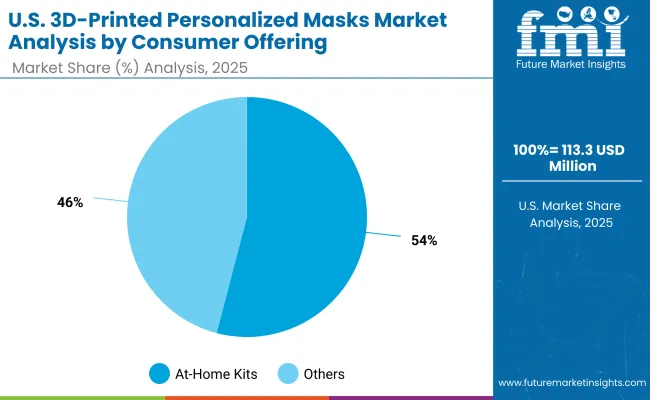
| USA by Consumer Offering | Value Share % 2025 |
|---|---|
| At-home kits | 54.1% |
| Others | 45.9% |
The 3D-Printed Personalized Masks Market in the United States is projected to sustain steady growth through 2035, driven by strong consumer adoption of at-home kits, which account for 54.1% of the market in 2025. This dominance underscores the USA preference for convenience-led, subscription-driven skincare solutions, where app-integrated printers allow customized mask creation at home. Clinical channels are also expanding, with dermatology practices integrating custom-fit hydration and recovery masks into advanced skin treatments, strengthening trust in medical-grade personalization.
Retail innovation is on the rise, as beauty chains in cities like New York and Los Angeles pilot smart kiosks and AR-linked mask printers, bridging digital convenience with in-store experiences. Together, the blend of consumer subscription models, clinical-grade offerings, and retail digitization positions the USA as one of the most balanced and innovation-ready markets globally.
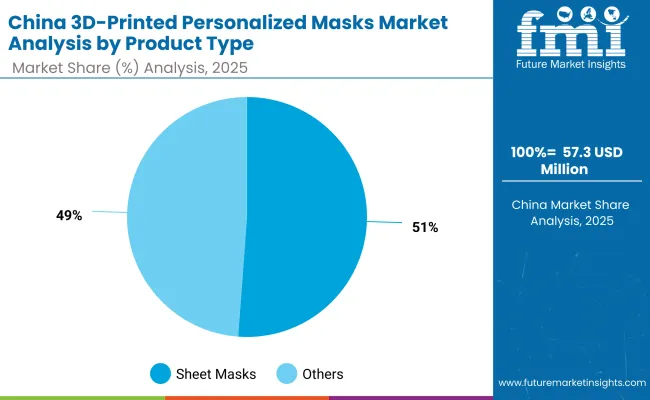
| China by Product Type | Value Share % 2025 |
|---|---|
| Sheet masks | 51.2% |
| Others | 48.8% |
The 3D-Printed Personalized Masks Market in China is projected to deliver significant growth opportunities, with sheet masks leading at 51.2% of the market in 2025. Their dominance reflects consumer comfort with familiar skincare formats that are now enhanced by personalization. Affordable localized devices are enabling mass-market adoption, while e-commerce platforms integrate subscription models for recurring sheet mask sales.
Beyond consumer applications, China’s biotech startups and cosmetic giants are advancing bio-ink formulations and sustainable substrates, opening opportunities for premium segments. Clinical channels are also expanding, where personalized sheet masks are being trialed in dermatology and recovery care. The convergence of affordability, government support for biotech-enabled consumer products, and the strength of China’s digital retail ecosystem positions sheet masks as the most lucrative opportunity segment in the country.
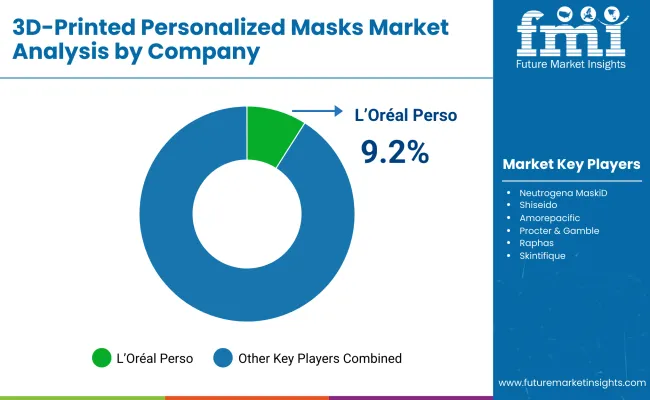
| Company | Global Value Share 2025 |
|---|---|
| L’Oréal Perso | 9.2% |
| Others | 90.8% |
The 3D-Printed Personalized Masks Market is moderately fragmented, with global beauty-tech leaders, regional cosmetic giants, and biotech-driven specialists competing across consumer and clinical applications. L’Oréal Perso leads the market with 9.2% share in 2025, driven by its AI-powered skin diagnostics and app-linked personalization platforms. Competitors such as Neutrogena MaskiD, Shiseido, Amorepacific, and Procter & Gamble are expanding their presence through subscription-driven at-home kits and partnerships with dermatology clinics.
Regional innovators, including Raphas, CELLINK, and BASF Care Creations, focus on bioprinting, bio-inks, and advanced material formulations to strengthen functionality and safety. These companies are aligning with sustainability goals by introducing biodegradable mask substrates and recyclable capsules. Niche-focused players such as Skintifique target clinical-grade and sensitive-skin solutions, emphasizing compliance with medical and regulatory standards.
Competitive differentiation is shifting from hardware capabilities to ecosystem-based offerings that integrate AI-driven personalization, AR/VR-enabled skin visualization, e-commerce subscriptions, and hybrid clinic-consumer solutions. This transition is fostering new alliances between cosmetic brands, biotech startups, and retail channels, where consumer engagement, recurring revenue, and ecosystem scalability are becoming the primary success factors.
Key Developments in 3D-Printed Personalized Masks Market
| Item | Value |
|---|---|
| Quantitative Units | USD 1,050.3 Million |
| Print Technology | Inkjet bioprinting , Extrusion-based, Laser-assisted |
| Function | Hydration, Anti-aging, Brightening, Spot treatment |
| Product Type | Sheet masks, Patches, Custom-fit gels, Capsules |
| Consumer Offering | At-home kits, In-store kiosks, Dermatology clinics |
| Regions Covered | North America, Europe, Asia-Pacific, Latin America, Middle East & Africa |
| Country Covered | United States, Canada, Germany, France, United Kingdom, China, Japan, India, Brazil, South Africa |
| Key Companies Profiled | L’Oréal Perso , Neutrogena MaskiD , Shiseido, Amorepacific , Procter & Gamble, Raphas , CELLINK, Stratasys , BASF Care Creations, Skintifique |
| Additional Attributes | Dollar sales by product type and consumer offering, adoption trends in personalized skincare routines and clinical recovery treatments, rising demand for at-home kits and AI-integrated mask printers, segment-specific growth in hydration, anti-aging, and brightening functions, material and bio-ink innovation for sheet masks, patches, and custom-fit gels, subscription-based sales models in e-commerce and retail channels, regional growth driven by beauty-tech ecosystems and sustainability initiatives, and advancements in inkjet bioprinting , extrusion-based, and laser-assisted printing technologies. |
The global 3D-Printed Personalized Masks Market is estimated to be valued at USD 1,050.3 million in 2025.
The market size for the 3D-Printed Personalized Masks Market is projected to reach USD 4,200.5 million by 2035.
The 3D-Printed Personalized Masks Market is expected to grow at a 14.9% CAGR between 2025 and 2035.
The key product types in the 3D-Printed Personalized Masks Market are sheet masks, patches, custom-fit gels, and capsules.
In terms of product type, the sheet masks segment is projected to command the largest share in the 3D-Printed Personalized Masks Market in 2025, accounting for 49.9% of global sales.






Our Research Products

The "Full Research Suite" delivers actionable market intel, deep dives on markets or technologies, so clients act faster, cut risk, and unlock growth.

The Leaderboard benchmarks and ranks top vendors, classifying them as Established Leaders, Leading Challengers, or Disruptors & Challengers.

Locates where complements amplify value and substitutes erode it, forecasting net impact by horizon

We deliver granular, decision-grade intel: market sizing, 5-year forecasts, pricing, adoption, usage, revenue, and operational KPIs—plus competitor tracking, regulation, and value chains—across 60 countries broadly.

Spot the shifts before they hit your P&L. We track inflection points, adoption curves, pricing moves, and ecosystem plays to show where demand is heading, why it is changing, and what to do next across high-growth markets and disruptive tech

Real-time reads of user behavior. We track shifting priorities, perceptions of today’s and next-gen services, and provider experience, then pace how fast tech moves from trial to adoption, blending buyer, consumer, and channel inputs with social signals (#WhySwitch, #UX).

Partner with our analyst team to build a custom report designed around your business priorities. From analysing market trends to assessing competitors or crafting bespoke datasets, we tailor insights to your needs.
Supplier Intelligence
Discovery & Profiling
Capacity & Footprint
Performance & Risk
Compliance & Governance
Commercial Readiness
Who Supplies Whom
Scorecards & Shortlists
Playbooks & Docs
Category Intelligence
Definition & Scope
Demand & Use Cases
Cost Drivers
Market Structure
Supply Chain Map
Trade & Policy
Operating Norms
Deliverables
Buyer Intelligence
Account Basics
Spend & Scope
Procurement Model
Vendor Requirements
Terms & Policies
Entry Strategy
Pain Points & Triggers
Outputs
Pricing Analysis
Benchmarks
Trends
Should-Cost
Indexation
Landed Cost
Commercial Terms
Deliverables
Brand Analysis
Positioning & Value Prop
Share & Presence
Customer Evidence
Go-to-Market
Digital & Reputation
Compliance & Trust
KPIs & Gaps
Outputs
Full Research Suite comprises of:
Market outlook & trends analysis
Interviews & case studies
Strategic recommendations
Vendor profiles & capabilities analysis
5-year forecasts
8 regions and 60+ country-level data splits
Market segment data splits
12 months of continuous data updates
DELIVERED AS:
PDF EXCEL ONLINE
Personalized Immunotherapy Market Size and Share Forecast Outlook 2025 to 2035
Personalized Packaging Market Size and Share Forecast Outlook 2025 to 2035
Personalized Toys Market Size and Share Forecast Outlook 2025 to 2035
Personalized Nutrition Market - Size, Share, and Forecast Outlook 2025 to 2035
Personalized Beauty Devices Market Trends - Growth & Forecast 2025 to 2035
Personalized Bakery Products Market Analysis by Product Type, Price Range, Sales Channel, End-User and Region 2025 to 2035
Personalized Medicine Market is segmented by Personalized Medicine Diagnostics, Medicine Therapeutics, and Medical Care from 2025 to 2035
Personalized Home Decor Market Insights & Forecast 2024-2034
Personalized Skincare Serum Market Trends – Demand & Forecast 2024-2034
Personalized Orthopaedic Implant Market
Hyper-Personalized Fitness Market Insights & Forecast 2025-2035
ETCO2 masks market
Disposable Masks Market Analysis by Product Type, Application, Closure, Sales Channel and Region 2025 to 2035
Probiotic Face Masks Market Size and Share Forecast Outlook 2025 to 2035
Anesthetic Gas Masks Market
Chelating Facial Masks Market Analysis - Size and Share Forecast Outlook 2025 to 2035
Charcoal-Based Detox Masks Market Analysis - Size, Share, and Forecast Outlook 2025 to 2035
Heat-Activated Beauty Masks Market Analysis - Size, Share, and Forecast Outlook 2025 to 2035
Nonrebreathing Oxygen Masks Market
Artificial Ventilation and Anaesthesia Masks Market Size and Share Forecast Outlook 2025 to 2035

Thank you!
You will receive an email from our Business Development Manager. Please be sure to check your SPAM/JUNK folder too.
Chat With
MaRIA